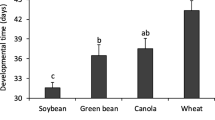Abstract
Studies on the effect of various diets on development, longevity and fecundity of Oxycarenus gossypinus were conducted in the laboratory at temperatures of 25–33°C. The mean periods of nymphal development when reared on seeds of okra, kenaf, roselle and cotton were 15.5, 15.7, 15.8 and 18.1 days, respectively.
Mated males lived longer and in decreasing order on okra (59.2 days), roselle (57.5 days) and kenaf (57.3 days) than on cotton (43.5 days). Mated females also lived longer on okra (41.4 days), kenaf (40.1 days) and roselle (39.3 days) than on cotton (32.5 days).
Mated females reared on okra seeds laid significantly the highest mean number of eggs per female per day (15.05 ± 0.87 eggs). But the mean number of eggs oviposited when fed on seeds of kenaf (12.9 ± 1.01 eggs) and roselle (10.9 ± 1.18 eggs) was not significant.
Résumé
Des études sur l’effet de différents régimes sur le développement, la longévité, et la fécondité du Oxycarenus gossypinus étaient entreprises au laboratoire à des températures de 25–33°C. Les périodes moyennes de développement nymphal quand ils sont élevés sur les graines de l’okra, du kenaf, de la roselle et du cotton étaient de 15,5; 15,7; 15,8 et 18,1 jours respectivement. Les mâles accouplés ont vécu plus longtemps et en ordre décroissant sur l’okra (59,2 jours), la roselle (57,5 jours) et le kenaf (57,3 jours), que sur le cotton (43,5 jours). Les femelles accouplées vivaient aussi plus longtemps sur l’okra (41,4 jours), sur le kenaf (40,1 jours), et sur la roselle (39,3 jours) que sur le cotton (32,5 jours).
Similar content being viewed by others
References
Adu-Mensah K. and Kumar R. (1977) Ecology of Oxycarenus species (Heteroptera: Lygaeidae) in Southern Ghana. Biol. J. Linn. Soc. 9, 349–377.
Engelmann F. (1970) The Physiology of Insect Reproduction. Pergamon Press, Oxford.
Kirkpatrick T. W. (1923) The Egyptian cotton seed bug (Oxycarenus hyalinipennis Costa). Its bionomics, damage and suggestion for remedial measures. Bull. Minist. Agrie. Egypt tech, scient. Serv. 35, 107.
Odhiambo T. R. (1957) The bionomics of Oxycarenus species (Hemiptera: Lygaeidae), and their status as cotton pests in Uganda. J. ent. Soc. sth. Afr. 20, 235–249.
Samy O. (1969) A revision of the African species of Oxycarenus (Hemiptera:Lygaeidae). Trans. R. ent. Soc. Lond. 121, 79–165.
Slater J. A. (1964) A Catalogue of the Lygaeidae of the World. Storrs, Conn.
Author information
Authors and Affiliations
Rights and permissions
About this article
Cite this article
Ewete, F.K., Osisanya, E.O. Effect of Various Diets (Seeds) on Development, Longevity and Fecundity of the Cotton Seed Bug, Oxycarenus Gossypinus Distant (Heteroptera: Lygaeidae). Int J Trop Insect Sci 6, 543–545 (1985). https://doi.org/10.1017/S1742758400004380
Received:
Revised:
Published:
Issue Date:
DOI: https://doi.org/10.1017/S1742758400004380




